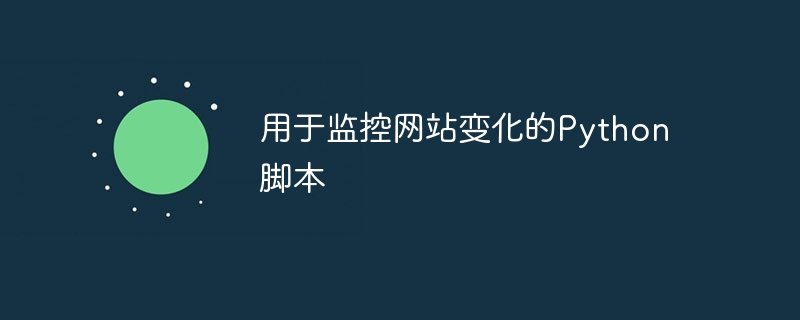

In today's digital age, knowing the latest changes on your website is crucial for various purposes, such as tracking updates on competitor websites, monitoring product availability, or staying informed about important information . Manually checking your website for changes can be time-consuming and inefficient. This is where automation comes into play.
In this blog post, we will explore how to create a Python script to monitor website changes. By leveraging the power of Python and some handy libraries, we can automate the process of retrieving website content, comparing it to previous versions, and notifying us of any changes. This allows us to remain proactive and react promptly to updates or modifications to the sites we monitor.
Before we start writing scripts to monitor website changes, we need to set up a Python environment and install the necessary libraries. Please follow these steps to get started -
Installing Python − If you have not already downloaded and installed Python, download and install it on your system. You can visit the Python official website (https://www.python.org/) and download the latest version compatible with your operating system. Make sure to select the option to add Python to your system path during installation.
Create a new Python virtual environment (optional)− It is recommended to create a virtual environment for this project to keep dependencies isolated. Open a terminal or command prompt, navigate to the desired project directory, and run the following command:
python -m venv website-monitor-env
This will create a new virtual environment called "website-monitor-env" in your project directory.
Activate Virtual Environment − Run the appropriate command based on your operating system to activate the virtual environment:
For Windows −
website-monitor-env\Scripts\activate.bat
For macOS/Linux −
source website-monitor-env/bin/activate
You should see the virtual environment name in the command prompt or terminal, indicating that you are working in a virtual environment.
Install the required libraries − After activating the virtual environment, let’s install the necessary libraries. In a terminal or command prompt, run the following command:
pip install requests beautifulsoup4
The "requests" library will help us retrieve website content, while "beautifulsoup4" will assist in parsing the HTML.
After setting up the Python environment and installing the required libraries, we can start building the website change monitoring script. In the next section, we'll walk through the process of retrieving website content using the "requests" library.
In order to monitor website changes, we need to retrieve the current content of the website and compare it with previously saved versions. In this section, we will use the "requests" library to get website content. Please follow these steps:
Import the necessary modules− Open your Python script and import the required modules first−
import requests from bs4 import BeautifulSoup
The "requests" module will handle HTTP requests, while the "BeautifulSoup" class in the "bs4" module will help us parse the HTML content.
Specify the website URL − Determine the URL of the website you want to monitor. For example, we use the URL "https://example.com" for demonstration. Replace it with the actual URL of the website you want to monitor.
url = "https://example.com"
发送 GET 请求并检索内容− 使用“requests.get()”方法向网站 URL 发送 GET 请求并检索内容。将响应分配给变量以进行进一步处理。
response = requests.get(url)
检查响应状态−最好检查响应的状态以确保请求成功。我们将使用“response.status_code”属性,该属性应在请求成功时返回状态代码 200。
if response.status_code == 200:
# Proceed with further processing
else:
print("Failed to retrieve website content. Status code:", response.status_code)
# Handle error or exit the script
检索网站内容后,您可以将其与之前保存的版本进行比较,以确定是否有任何更改。
一旦我们检索了网站内容,我们需要将其保存以供将来比较。在本节中,我们将讨论如何保存内容并将其与以前保存的版本进行比较。请按照以下步骤操作−
保存初始网站内容 − 检索网站内容后,将其保存到文件中以供将来比较。创建一个新文件并使用“write()”方法将内容写入其中。例如−
with open("website_content.txt", "w") as file:
file.write(response.text)
这会将网站内容保存在当前目录中名为“website_content.txt”的文件中。
与之前的内容进行比较− 为了检测更改,我们需要将当前网站内容与之前保存的版本进行比较。从保存的文件中读取内容并将其与新内容进行比较。例如−
with open("website_content.txt", "r") as file:
previous_content = file.read()
if response.text == previous_content:
print("No changes detected.")
else:
print("Website content has changed.")
# Perform further actions for handling the changes
在这里,我们将响应中的新内容与从文件中读取的内容进行比较。如果它们匹配,则不会检测到任何更改。否则,我们会打印一条消息,表明网站内容已更改。
更新保存的内容 − 如果检测到更改,我们应该使用新版本更新保存的内容。这将确保下一次比较是针对最新内容进行的。使用与之前相同的文件写入逻辑来更新内容:
with open("website_content.txt", "w") as file:
file.write(response.text)
通过覆盖文件,我们将新内容保存为最新版本。
通过执行以下步骤,您可以保存初始网站内容,将其与未来版本进行比较,并识别任何更改。在下一节中,我们将探讨如何使用 Python 脚本自动执行此过程。
每次我们想要监视网站的更改时手动运行脚本可能是乏味且不切实际的。在本节中,我们将讨论如何使用 Python 脚本和调度工具自动化网站监控过程。请按照以下步骤操作:
创建 Python 脚本− 打开您喜欢的 Python 编辑器或 IDE 并创建一个新的 Python 脚本文件。您可以将其命名为“website_monitor.py”。
导入必要的模块− 在脚本的开头,导入所需的模块,包括用于发出 HTTP 请求的“请求”和用于在请求之间添加延迟的“时间”。此外,导入您可能需要的任何其他模块,用于根据网站更改发送通知或执行其他操作。
import requests import time # Import other modules as needed
定义网站网址和监控间隔 − 通过将要监控的网站的 URL 分配给变量来设置它。另外,指定您要检查更改的时间间隔。此间隔可以以秒、分钟或任何其他合适的单位为单位。
website_url = "https://example.com" monitoring_interval = 300 # Check every 5 minutes
创建监控函数− 定义一个封装监控逻辑的函数。该函数将负责发出 HTTP 请求、比较网站内容并根据更改执行任何所需的操作。
def monitor_website():
while True:
# Make the HTTP request to the website
response = requests.get(website_url)
# Compare the current content with the saved content
with open("website_content.txt", "r") as file:
previous_content = file.read()
if response.text != previous_content:
print("Website content has changed.")
# Perform desired actions for handling the changes
# Update the saved content
with open("website_content.txt", "w") as file:
file.write(response.text)
# Wait for the specified interval before the next check
time.sleep(monitoring_interval)
调用监控函数− 在脚本末尾添加对 monitor_website() 函数的调用以启动监控过程。
monitor_website()
保存脚本 − 将 Python 脚本文件保存在系统上的适当位置。
安排脚本 − 要自动化监控过程,您可以使用 cron(在基于 Unix 的系统上)或任务计划程序(在 Windows 上)等调度工具。设置计划以所需的时间间隔执行脚本,确保其在后台连续运行。
此脚本将定期检查网站内容的更改并相应地执行任何指定的操作。
监控网站更改对于及时了解最新内容或检测可能影响您的业务或个人利益的任何修改至关重要。在本文中,我们探讨了如何创建 Python 脚本来监控网站更改。通过利用 Python 及其库的强大功能,我们可以自动化该过程并及时收到有关任何修改的通知。
我们首先了解网站监控的重要性及其带来的好处。然后,我们深入研究了构建监控脚本所需的步骤。我们学习了如何发出 HTTP 请求、比较网站内容以及根据更改执行操作。此外,我们还讨论了使用调度工具自动执行脚本的选项,确保无需人工干预即可持续监控。
The above is the detailed content of Python script for monitoring website changes. For more information, please follow other related articles on the PHP Chinese website!




